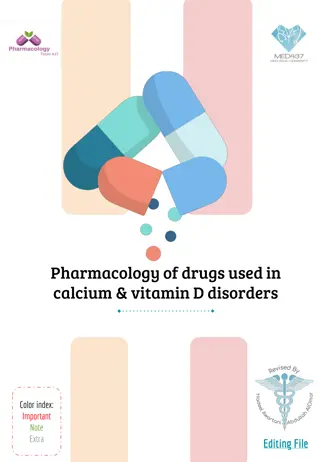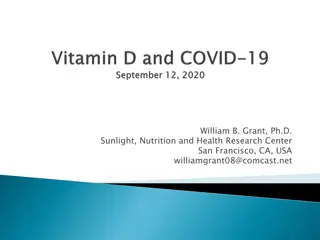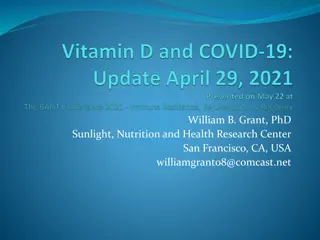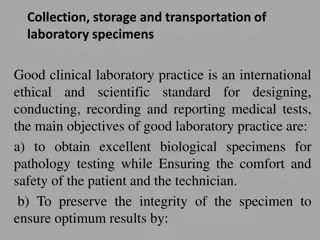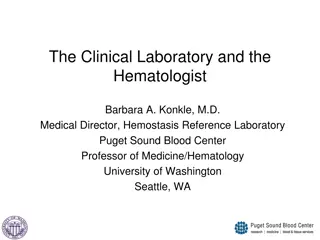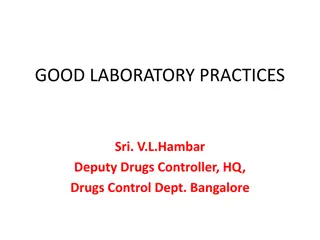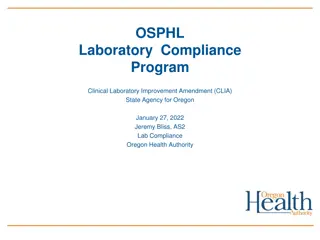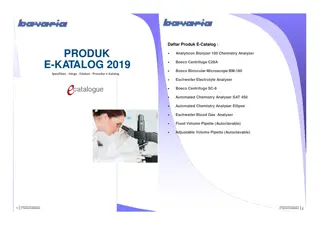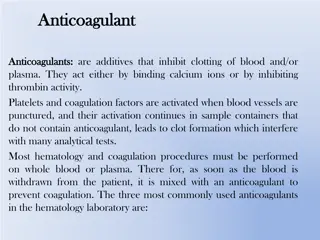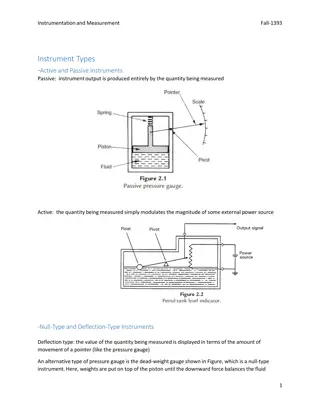Understanding Vitamin D: Clinical Relevance and Laboratory Measurement
This presentation delves into the clinical importance and laboratory measurement of Vitamin D, covering topics such as its formation, metabolism, forms, functions, deficiency causes, and typical biochemistry. It explores the impact of different genetic variants of Vitamin D binding protein, the role of Vitamin D in calcium homeostasis, bone health, muscle strength, and potential links to various health conditions.
Download Presentation

Please find below an Image/Link to download the presentation.
The content on the website is provided AS IS for your information and personal use only. It may not be sold, licensed, or shared on other websites without obtaining consent from the author. Download presentation by click this link. If you encounter any issues during the download, it is possible that the publisher has removed the file from their server.
E N D
Presentation Transcript
Vitamin D: clinical relevance and laboratory measurement Ed Wilkes PhD Senior Clinical Scientist
Formation of endogenous vitamin D 7-dehydrocholesterol Vitamin D3 25-hydroxyvitamin D3 1,25-dihydroxyvitamin D3
Metabolism of vitamin D 25-hydroxyvitamin D 1,25-dihydroxyvitamin D Inactivation Biliary excretion 24,25-dihydroxyvitamin D 1,24,25-trihydroxyvitamin D Calcitroic acid
Forms of vitamin D Vitamin D2 Ergocalciferol Vitamin D3 Cholecalciferol Exogenous form Endogenous form Shorter half-life Longer half-life
Vitamin D in circulation 25-hydroxyvitamin D is the main circulating form 25-hydroxyvitamin D circulates bound to vitamin D binding protein (VDBP) VDBP VDBP + Evidence suggests that different genetic variants of VDBP have different affinities for vitamin D This may have an impact on total vitamin D circulating levels and their clinical interpretation (cf free/bioavailable testosterone Powe et al. NEJM 2013)
Functions of vitamin D 1,25-dihydroxyvitamin D is the active form Its primary effects are on calcium homeostasis and include: 1. Increasing gut absorption of calcium and phosphate 2. Stimulating bone resorption Non-musculoskeletal effects include: 1. Regulation of PTH secretion 2. Blood pressure regulation via renin 3. Pancreatic insulin secretion 4. Immunomodulation 5. Regulation of apoptosis
Vitamin D deficiency Vitamin D deficiency can have several aetiologies Inadequate exposure to UV light reduced vitamin D formation Hepatic disease reduced 25-hydroxylation of vitamin D Renal disease reduced 1-hydroxylation of vitamin D Inadequate intake / malabsorption reduced vitamin D available for hydroxylation Deficiency classically results in bone loss, muscle weakness, fractures More clinically relevant in those with low calcium diets (e.g., veganism) Some evidence to suggest link to cardiomyopathy in infants (Maiya et al. Heart 2008)
Vitamin D deficiency typical biochemistry Typical bone profile in early vitamin D deficiency in an adult: Analyte Corrected calcium Phosphate ALP PTH 25-hydroxyvit D Result Reference range Interpretation Normal Low High High Low 2.3 0.7 223 14.5 31 2.2 2.6 0.8 1.5 30 130 1.1 6.8 70 150 Typical bone profile in severe vitamin D deficiency in an adult: Analyte Corrected calcium Phosphate ALP PTH 25-hydroxyvit D Result Reference range Interpretation Low Low High High Low 1.7 0.5 343 32.8 17 2.2 2.6 0.8 1.5 30 130 1.1 6.8 70 150
Measurement of vitamin D in the laboratory 25-hydroxyvitamin D is the most commonly measured form in the lab We can measure this metabolite with one of two methods: 1. Immunoassay 2. Liquid chromatography-tandem mass spectrometry (LC-MS/MS) What about the other forms? Unhydroxylated vitamin D is hard to measure 1,25-dihydroxyvitamin D is unstable and is rarely of clinical use
Immunoassay pros and cons + Fully automated (available 24/7) + Work well in the majority of clinical settings + Analytically sensitive - Cannot distinguish between 25-hydroxyvitamin D3 and D2 - The cross-reactivity for D2 is not perfect and often underestimates its levels - Assays are poorly standardised - Often cross-reacts with 24-hydroxylated and other vitamin D forms
LC-MS/MS Mass spectrometers measure the mass-to-charge ratio (m/z) of ions We can target the analysis for ions of a specific mass-to-charge Very selective and specific! Sample mixture Q1 Q2 Q3 Mass analysis of precursor ion Mass analysis of fragment ions Fragmentation 384.6 Relative intensity Relative intensity m/z m/z
LC-MS/MS pros and cons + Very analytically specific + Can distinguish between D3 and D2 + Analytically sensitive - Assays are relatively poorly standardised - Not available 24/7 - Slower assay - Unnecessary in most instances
Local assays at NWLP Immunoassay (total 25-hydroxyvitamin D) Appropriate for vast majority of requests where patients are: At risk and ?deficient Supplemented with vitamin D3 LC-MS/MS Appropriate when patients are being supplemented with vitamin D2 ( D3) Appropriate when patients are on vitamin D but you are not sure which type
Who to test? Patients at risk of vitamin D deficiency Ageing Certain drugs (e.g., phenytoin, rifampicin, glucocorticoids, anti-retrovirals) Pigmented skin Sunshine avoidance Obesity Low calcium (and high fibre) diets (e.g., vegan) Liver disease Patients with an indicative bone profile Hypocalcaemia Hypophosphataemia Appropriately raised PTH
Who not to test? Patients with no risk factors Patients with renal disease 25-hydroxyvitamin D may be normal
Interpretation of results Interpretation is based on total 25-hydroxyvitamin D (D2 + D3) 70 150 nmol/L Replete does not need replacement/continue with current regimen 40 70 nmol/L Insufficient prescribe maintenance dose if required Consider referral to secondary care if on aforementioned drugs, patient is osteopaenic/osteoporotic, hypocalcaemic, CKD3/4, or if evidence of secondary hyperparathyroidism < 40 nmol/L Deficient prescribe loading dose Important to note that > 150 nmol/L may be indicative of vitamin D intoxication check calcium! Adult and paediatric treatment guidelines are available on the Trust website
When to re-test? RCPath guidelines state the following: No clinical signs and symptoms do not retest Chole-/ergocaliferol therapy for whatever clinical indication, where baseline vitamin D was adequate do not retest Chole-/ergocalciferol therapy for whatever clinical indication, where baseline vitamin D was low and where disease that might impact negatively on absorption is present repeat after 3-6 months on recommended replacement dose It can take ~6 months to reach a steady-state on treatment Calcitriol or alphacalcidol therapy do not measure vitamin D
Acknowledgements The Endocrinology/LC-MS/MS team: Dr Emma Walker Consultant Clinical Scientist/Lead Healthcare Scientist Matthew Whitlock Principal Clinical Scientist Dr Sarah Darch Senior Clinical Scientist Dr Cassie Porchetta Senior Clinical Scientist Amal Bashir Senior Biomedical Scientist Priya Pattni Biomedical Scientist Thelma Omeire Biomedical Scientist Sherrine Alleyne Biomedical Scientist Somia Janjua Biomedical Scientist





